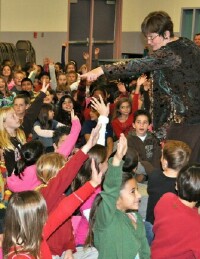 Are you working on a new presentation? Or perhaps trying to beef up an old one? One of the best ways to get fresh ideas is to see authors and illustrators in action. And festival showcases are a perfect way to see many all in one spot in a single day.
Are you working on a new presentation? Or perhaps trying to beef up an old one? One of the best ways to get fresh ideas is to see authors and illustrators in action. And festival showcases are a perfect way to see many all in one spot in a single day.
Case in point: on Saturday, November 14, 2015 from 10:00 a.m. – 3:00 p.m., over 30 authors and illustrators are appearing at the first-ever Western New York Children’s Book Expo at Kleinhans Music Hall in Buffalo, New York. (And, full disclosure, I will be among them, doing a presentation from 12:30 – 12:45 p.m. at the Buffalo News Literacy Corner, and signing books all day, so stop by!)
Because a festival crowd is fluid and multi-age, the showcases are only 15 minutes long. By observing authors, you’ll pick up tips on how they open, what they focus on, how they engage the audience, and how they wrap up in such a short amount of time.
This extravaganza is being organized by Kim Krug and Kathleen Skoog and their team at Monkey See, Monkey Do…Children’s Bookstore of Clarence, NY. In 2012, the store received the Women’s National Book Association (WNBA) Pannell Award, given out to recognize and publicly applaud the work of booksellers who stimulate, promote and encourage children’s and young people’s interest in books. Then in December 2014, author and philanthropist James Patterson gifted Monkey See, Monkey Do…Children’s Bookstore with seed money that started things rolling, and local businesses are helping to bring this to the public for FREE.
For more information on the WNY Children’s Book Expo (location, schedule, book pre-order discounts) click here.
For a downloadable flier, click here. Pass it along to your friends in Western New York!

